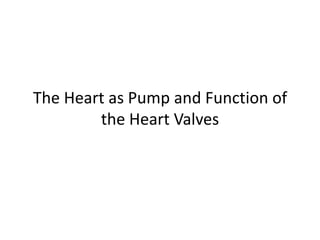
Lec16(cvs)
- 1. The Heart as Pump and Function of the Heart Valves
- 2. The Heart Pumps The Heart Two separate pumps Right heart that pumps blood through the lungs Left heart that pumps blood through the peripheral organs Each of these hearts compose of an atrium and a ventricle
- 3. Pulmonary circuit blood to and from the lungs Systemic circuit blood to and from the rest of the body Vessels carry the blood through the circuits Arteries carry blood away from the heart Veins carry blood to the heart Capillaries permit exchange The cardiovascular system is divided into two circuits
- 4. Heart Chambers Two Atria- upper chambers Interatrialseptum- separates right and left atrium Right atrium receives blood from the systemic circulation via superior and inferior vena cavae, while left atrium receives blood from the lungs via pulmonary veins Two Ventricle- lower chambers Interventricular septum- separates right and left ventricles Right ventricle supplies the lung circuit via pulmonary artery. Left ventricle supplies the systemic circuit via aorta
- 5. Heart Wall Pericardium Double layered structure enclose the heart Myocardium Compose of cardiac muscle, thick muscular layer Endocardium smooth inner lining
- 6. Heart Wall Pericardial cavity contains 5-30 ml of pericardial fluid
- 7. Heart Valves Atrioventricular valves (A- V valves) prevent backflow of blood from the ventricles to atria during systole Tricuspid valve- between right atrium and right ventricle Bicuspid valve- between left atrium and left ventricle The tricuspid and mitral valves consist of flaps which are attached at the periphery of the valve ring Chordae Tendinae, cord like structures originate from papillary muscles are attached to the free edges of the valve flaps
- 8. Semilunar valves- prevent backflow from the aorta and pulmonary arteries into the ventricles during diastole Pulmonary valve- between pulmonary artery and right ventricle Aortic valve- between aorta and left ventricle Heart Valves
- 9. Heart Valves Except the mitral valve, all the remaining heart valves consist of 3 flaps
- 10. Internal Anatomy Anterior Aspect
- 11. Heart Flow Blood flows through the heart from areas of higher blood pressure to lower Deoxygenated blood from the body enters the right atrium of the heart through the vena cava Blood flows from right atrium through the tricuspid valve into the right ventricle Ventricular pumping pushes blood through pulmonary valve out the pulmonary trunk to the lungs
- 12. Heart Flow con’t. Blood becomes oxygenated in the lungs and enters the left atrium Blood flows through the bicuspid valve into the left ventricle Ventricular pumping pushes oxygenated blood out the aortic valve Blood travels to all parts of the body to drop of needed oxygen
- 14. AV Valve Mechanics Ventricles relax, pressure drops, semilunar valves close, AV valves open, blood flows from atria to ventricles Ventricles contract, pressure rises, AV valves close, (papillary m. contracts and pulls on chordae tendineae to prevent the bulging of valve into the atria) pressure rises and semilunar valves open, blood flows into arteries
- 15. Operation of Atrioventricular Valves
- 16. Operation of Semilunar Valves
- 17. Physiology of Cardiac Muscle The heart composed of three types of cardiac muscle Atrial muscle Ventricular muscle Excitatory and conductive muscle fibers
- 18. The atrial and ventricular types muscle contraction is similar to skeletal muscle contraction, i.e., sliding-filaments but duration of contraction is much longer Excitatory and conductive fibers exhibit automatic rhythmical electrical discharge in the form of action potential Physiology of Cardiac Muscle
- 19. Short, thick, branched cells, 10 to 20 m wide with one central nucleus Sarcoplasmic reticulum T tubules much larger than in skeletal muscle, admit more Ca2+ from ECF during excitation Intercalated discs, join myocytes end to end mechanical junctions tightly join myocytes gap junctions form channels allowing ions to flow directly into next cell Structure of Cardiac Muscle
- 20. Structure of Cardiac Muscle Cell
- 21. Differences Between Skeletal and Cardiac Muscle Physiology Action potential of skeletal muscle is caused by opening fast sodium channels. Action potential in cardiac muscle is caused by fast sodium channels and slow calcium channels
- 22. Differences Between Skeletal and Cardiac Muscle Physiology Action Potential Cardiac: Action potentials conducted from cell to cell Duration 0.25 sec Skeletal, action potential conducted along length of single fiber Duration 1 – 5 msec Rate of Action Potential Propagation Slow in cardiac muscle because small diameter of fibers 0.3-0.5 m/sec. Faster in skeletal muscle due to larger diameter fibers 3-5 m/sec. Calcium release Movement of extracellular Ca2+ through plasma membrane activate the muscle contractile process in cardiac muscle Action potential in T-tubule stimulates Ca++ release from sarcoplasmic reticulum
- 23. Refractory Period of Cardiac Muscle The refractory period of the heart is the interval of time during which a normal cardiac impulse cannot re-excite an already excited area of the cardiac muscle. Lasts 0.25-0.30 sec in ventricles
- 24. Refractory Periods Skeletal Muscle Cardiac Muscle Cardiac muscle tissue has a longer refractory period than skeletal muscle. This prevents the heart from going into tetany.
